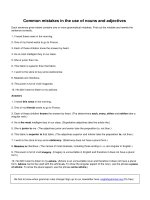Teachers' use of elicitation techniques to teach speaking skill to first-year students of University of Engineering and technology, Vietnam national University, Hanoi
Bạn đang xem bản rút gọn của tài liệu. Xem và tải ngay bản đầy đủ của tài liệu tại đây (138.25 KB, 4 trang )
Teachers' use of elicitation techniques to teach
speaking skill to first-year students of
University of Engineering and technology,
Vietnam national University, Hanoi
Việc sử dụng các thủ thuật gợi mở của giáo
viên để dạy kĩ năng nói cho sinh viên năm thứ
nhất, trường ĐH Công nghệ,
ĐH Quốc Gia Hà Nội
Chu Thị Huyền Mi
University of Languages and International Studies
M.A. Thesis. English Teaching Methodology; Mã số: 60 14 10
Supervisor : M.A. Nguyễn Minh Tuấn
Năm bảo vệ: 2012
Abstract. Application of Communicative Language Teaching into English classrooms
has mushroomed worldwide, and employment of elicitation techniques to enhance
learners’ competence in spoken English is not an exception. However, how to
maximize the outcomes of those techniques among Vietnamese students in general and
to non-English-major students is always a big concern to educators. This study was
conducted with a view to examining teachers’ use of elicitation techniques to teach
speaking skill to first-year students at University of Engineering and Technology,
Vietnam National University, Hanoi. To be more specific, the researcher desired to
investigate teachers’ concept of elicitation teaching, their actual implementation and
effects of elicitation techniques on their students’ spoken English skill. The three
objectives were expected to be accomplished by a triangulation of three data collection
instruments including questionnaire, interview and classroom observation. Targeting at
first-year student population, the study could involve 80 of them in the questionnaire
survey and ten teachers in both questionnaire and interviews. Classroom observation
was also implemented to support and test the results gained from the former
instruments. Upon data analysis, the researcher could work out important findings as
follows, i.e. most of the studied teachers had an adequate understanding of elicitation
teaching and used it with high frequency. “Increasing students’ talk” was the most
significant effect of elicitation whereas “time consumption” was the biggest
shortcoming of the techniques. Regarding their actual implementation, all techniques,
especially questioning, were used on a regular basis to elicit students’ talk. The
manners of elicitation which were paid the most attention to included “combining
different techniques”, “alternating types of questions” and “direct questions to a variety
of students”. The findings could after all generate meaningful pedagogical implications
for students, teachers and educational authorities.
Keywords. Tiếng Anh; Kỹ năng nói; Phương pháp giảng dạy; Thủ thuật gợi mở
Content.
The rest of the paper consists of four following chapters.
Chapter 2 provides background theories underlying the issue including definition
of key concepts and relevant knowledge in accordance with a review of related studies
of the same field.
Chapter 3 presents the methodology of the research including features of
participants, research setting, research instruments, data collection and data analysis
procedure.
Chapter 4 reports and discusses findings which answer the four research
questions. It also offers recommendations to relevant parties so as to accomplish a
higher effectiveness of elicitation teaching.
Chapter 5 summarizes major findings, highlights contributions of the research,
puts forward practical suggestions for future research as well as addresses noted
limitations of the study.
In conclusion, the initial chapter has presented basic understanding of the
research including rationales for doing the research, objectives, scope, significance and
overview of the rest of the paper.
References.
Chu T. H. M. (2009), Techniques teachers use to elicit grade-10 students’ talk in
upper-secondary schools in Hanoi, Unpublished BA thesis, ULIS, VNU,
Hanoi.
Cornejo R., Weistein A. and Najar C. (1983), Eliciting spontaneous speech in
bilingual students: Methods and techniques, Educational Resources
Information Center and Clearinghouse on Rural Education and Small Schools,
New Mexico.
Cohen L., Manion L. and Morrison K. (2000), Research methods in education,
Routledgefalmer, London.
Darn and Cetin (2009), Eliciting, Retrieved from
on 20 November 2011.
Darn S. (2008), “Asking questions”, The BBC and British Council. Retrieved from
on
November 21 2011.
Doff A. (1988), Teach English: A training course for teachers, Cambridge University
Press, Cambridge.
Ersoz A. (2000), “Six Games for the EFL/ESL Classroom”, The Internet TESL
Journal, 6 (6).
Harmer J. (2001), The practice of English Language Teaching, Longman ELT,
London.
Kumaravadivelu B. (1993), “Maximizing learning potential in the communicative
classroom”, English Language Teaching Journal, 47 (1), pp. 12- 21.
Lee K. (1995), “From Creative Games for the Language Class”, Forum, 33 (1).
Mehan H. (1979), Learning lessons: Social organization in the classroom, MA,
Harvard University Press, Cambridge.
Milne J. (1999), Questionnaires: Advantages and Disadvantages. Retrieved from
on 12
December 2011.
Nguyen T. T. (2011), The exploitation of eliciting techniques by fourth-year students
in their teaching practicum at English Division 1, Faculty of English Language
Teacher Education, University of Languages and International Studies,
Vietnam National University, Unpublished BA thesis, ULIS, VNU, Hanoi.
Nguyen T.T.H. and Khuat T.T.N. (2003), “Learning Vocabulary through Games”,
Asian EFL Journal.
Nunan D. (1991), “Communicative tasks and the language curriculum”, TEOSL
Quarterly, 25 (2).
Oxford Advanced Learner’s Dictionary (2008), Oxford University Press, Oxford.
Pham H. (2006), Using elicitation techniques to teach Vocabulary to 11
th
form
students in Hanoi, Unpublished BA thesis, English Department, CFL, VNU,
Hanoi.
Richard J.C. (2005), Communicative Language Teaching Today, Cambridge
University Press, New York.
Rudder M. (2000), “Eliciting student-talk”, English Teaching Forum, 37(2), pp. 17-
19.
T. N. (2004), Tiếng Anh của sinh viên Việt Nam ở trình độ rất thấp so với thế giới.
Retrieved from />o-trinh-do-rat-thap-so-voi-the-gioi/45125542/202/ on 20
November 2011.
To T. H., Nguyen T.M. and Nguyen T.T. (2008), ELT Methodology I Course Book. ULIS, VNU,
Hanoi.
Tran H. (2007), Eliciting technique to teach speaking skill to grade-10 students at
Hanoi Foreign Language Specializing School, Unpublished BA thesis, English
Department, CFL, VNU, Hanoi.
Ur P. (1996), A course in language teaching: Practice and theory, Cambridge
University Press, Cambridge.
Wright A., Betteridge M. and Buckby M. (1984), Games for Language Learning,
Cambridge University Press, Cambridge.









